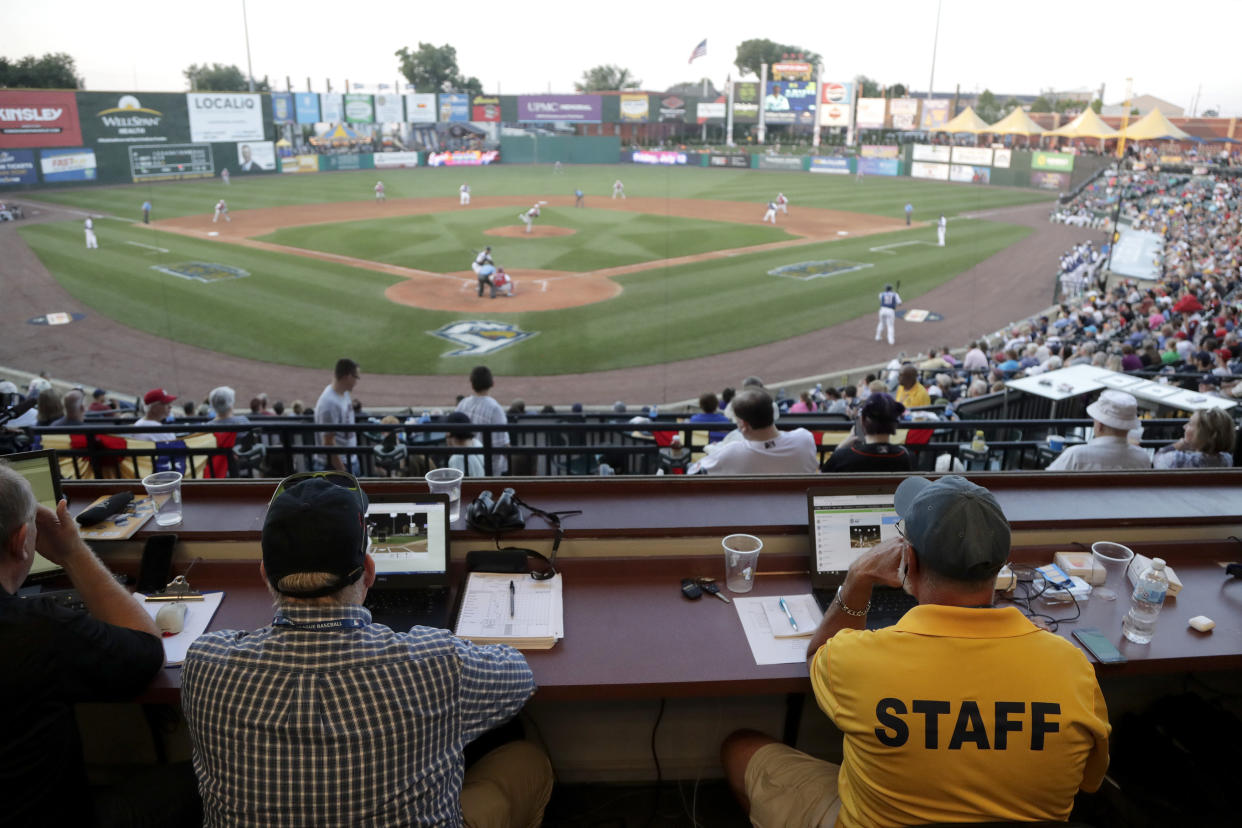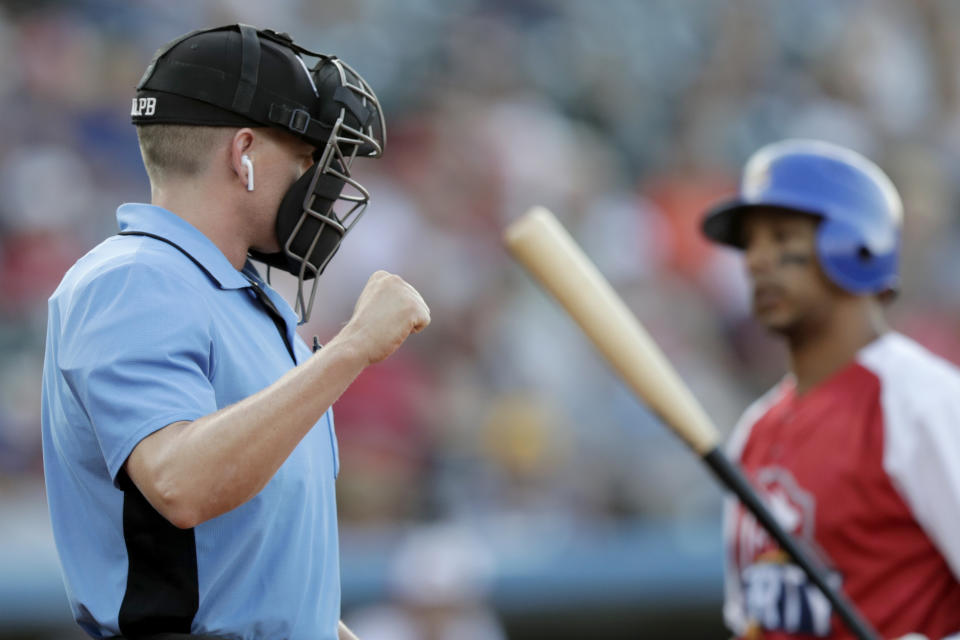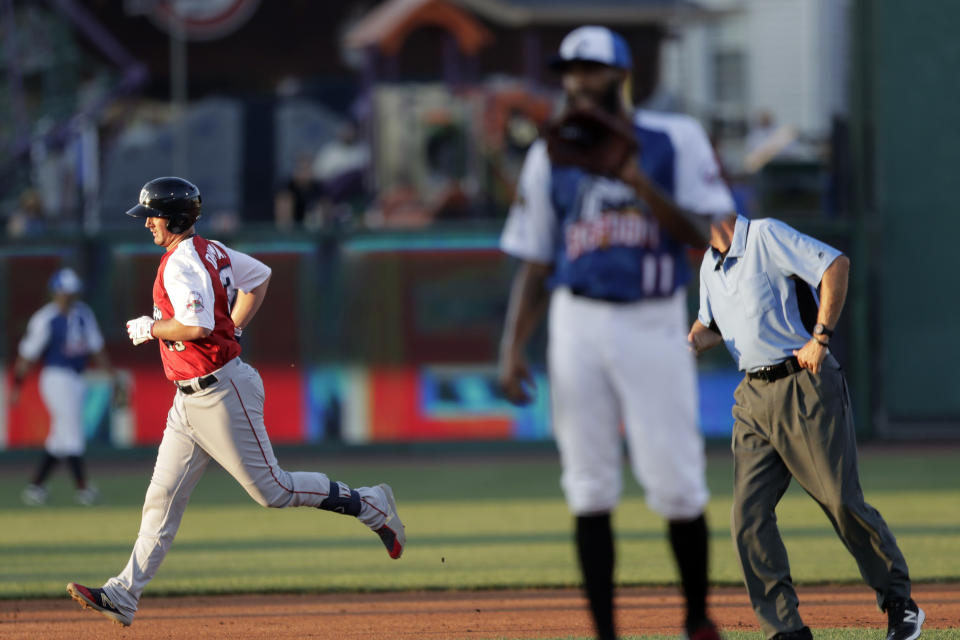The Atlantic League is proving that change can be hard for baseball players

CENTRAL ISLIP, N.Y. — Immediately following the seventh inning of a game between the New Britain Bees and the hometown Long Island Ducks last week, there was a ceremony on the field at Bethpage Ballpark to induct the newest inanimate member of the Hall of Fame. Even if you were among the small crowd that came out to watch independent ball in person on a warm Thursday night, you might’ve missed it. The whole thing took less than a minute and 45 seconds because it had to — abbreviated time between innings is one of the handful of rule changes that Major League Baseball is piloting in the Atlantic League this season.
Ducks owner Frank Boulton slipped out of the stands to receive the earpiece that home plate umpire Fred DeJesus had been wearing all evening. A couple of pictures were snapped, and then Boulton returned to the stands as DeJesus donned a new earpiece so the game could go on.
From there, the earpiece would head to Cooperstown to commemorate the official league-wide rollout of the Automated Ball-Strike System (ABS) powered by TrackMan. Or, as everyone has taken to colloquially calling it, robot umps.
“It’s hard for me to put into words how momentous what we’re watching is ’cause it looks so ordinary,” Atlantic League commissioner Rick White said, watching the small ceremony play out from seats just behind the first-base dugout. “That looks like any pitch you’ve ever seen at any ballpark. When Freddie calls a strike, it looks like any strike call you’ve ever seen at any ballpark. But when I think about what’s gone into this, and the incredible amount of resource and time everyone has put into this, especially our umpires, it’s a hugely momentous thing.”
How robot umps came to be in the Atlantic League
The automated strike zone, which is monitored by an MLB employee in a booth above the gameplay, has been the headliner of a new three-year partnership between MLB and the indy league. In exchange for TrackMan systems at each stadium, MLB statistical services, and a public association with the league that has increased its national profile and driven reporters to places like Central Islip, Long Island, the Atlantic League has given MLB unmitigated authority to dictate on-field rule changes.
Some, like shorter inning breaks, have been welcome. Bigger bases — now 18 square inches, up from 15 — presented a little bit of a visual shock at the start of the season but have been universally embraced as a safety measure. Having proven successful at keeping first basemen’s ankles un-trampled, those seem destined for the bigs.

The point of those changes is not to shift the game perceptibly but rather to codify an ideal version in which injurious collisions and commercial breaks are decreased. The same is true of the robot umps, extreme as it may seem (especially to umpires). We have the technology to make the strike zone more consistent, less frustrating, and implementing that technology seems inevitable if it can be sufficiently reliable.
“What we’re doing now with TrackMan, I believe 100 percent that it’ll be done into the minor leagues,” Ducks manager Wally Backman told Yahoo Sports. “And down the road, I believe there’s a very good chance that it happens in the major leagues.”
The Atlantic League, then, serves as less of a workshop and more of a dry run when it comes to robot umps — a chance to work out the kinks, correct for the too-high strike, ensure that earpieces can be switched out seamlessly when necessary. Catchers will have to adjust their approach if pitch framing is rendered moot. But, if it works, the Automated Ball-Strike System should not change the progression of the game at all, except for the loss of the arguments between managers and umpires over a botched call.
“I can take a bat up there and beat TrackMan up,” Backman said.
Barring an unforeseen malfunction by TrackMan and an ill-timed bumbling by the actual home-plate ump — who has the authority to overrule the computer as needed — a game officiated by ABS should appear indistinguishable from a game officiated entirely by fallible humans.
The same, however, cannot be said for some of the other potential rule changes currently being beta-tested by actual ballplayers who don’t always relish their role as the first line of defense against bad ideas.
“I don’t think we’re excited about them,” Ducks infielder T.J. Rivera told Yahoo Sports, who played in the majors with the Mets. “You feel like you’re the lab rat out there.”
Except, they’re not really lab rats at all — which is part of the problem. They’re self-aware, sentient professionals with decades of carefully honed muscle memory. And the current way of testing the rules is not a well-controlled experiment. About half of the rule changes went into effect at the start of the season, and the other half kicked in just a few weeks ago at the All-Star break. With 10 changes in total and the adjustment period still very much underway, some players are frustrated as they work through what is, in some ways, a whole new ballgame.
“You train yourself for years, mechanically, and to go about certain situations in a certain way, and those haven’t really adjusted yet in our minds,” Rivera said. He was referring specifically to the so-called “stealing first” rule, which allows batters to run on any count when the ball gets past the catcher.
“Some guys have done it, but you can just tell the reactions of guys in the box, guys are not like go once the ball gets behind the catcher,” he said. “Honestly, I’ve had a couple balls go past and the catcher take off and then it hit me like, ‘Oh, I can run.’ And by then it’s too late.”
His manager was more explicit: “Our guys have not really bought into that play yet.”
It’s impossible to gauge the impact of a potential rule change if the pilot participants are either unwilling or unable to fully engage with it. Stealing first has proven too extreme, while allowing for a two-strike foul bunt simply too forgettable. The Ducks lamented getting beat on a bunt recently when the defense dropped back after the batter got to two strikes. It’s the sort of thing that should course-correct eventually — traditional baseball is plenty unintuitive — but the learning curve could get ugly.
The new rule with the hardest learning curve
With stealing first, or even bunting with two strikes, the players can opt out and thus skew the study. The same cannot be said of the rule — implemented midway through the season — that pitchers must step off the rubber before attempting a pick-off throw. What may seem like a pedantic matter of inches has in fact proven to be the most impactful rule change yet.
“Will it work? I don’t know,” Backman said. “Is it like a track meet out there against some teams? Absolutely.”
Last Thursday, Ducks left-hander Darin Downs gave up three stolen bases and a balk. It was his second start since the rubber rule was imposed, and he had given up eight stolen bases in his first start after the break. The rule disproportionately impacts left-handers, who have designed their deliveries around deceptive leg lifts. Now, the moment a lefty’s right foot moves, baserunners are clear to take off. Rewiring those deliveries for pitchers who have never used a slide step is more than a quick adjustment.
“A guy gets to first base, two or three pitches later he’s on third. And then he’s getting in with a sac fly,” said Ducks right-hander Joe Iorio. He said that within the clubhouse there’s been some playful debate over who has it worse with the new rules — pitchers or position players — but the truth is, it’s no contest.
“It feels like a disadvantage to them. It’s not easy as a pitcher to have a guy get on first and then pretty much have second base,” Rivera said. “Not only that, then he’s taking third with ease ’cause there’s no inside move. So you’re pretty much giving a stolen base guy, with two extra pitches, he’s got third.”

Major league stolen-base rates haven’t been this low since the 1960s, and MLB would be wise to incentivize such a dynamic aspect of the game. So you could say the rule works — just perhaps a little too well.
Even though the game is always in flux, players and teams are finely tuned to existing structures. They’ve perfected not just running and throwing and hitting a ball but, especially at that level, the second-nature fringe physicality that the sport requires. And even though the balance between offense and defense and styles of play shifts constantly, it does continuously — favoring a certain skill set that then spreads throughout the game.
What the experimental rule changes at the Atlantic League are showing is just how hard it can be to step on the scale and shift that balance intentionally and discreetly without overdoing it or making the game worse first because the players are suddenly handicapped by their muscle memory.
“Unless there’s a new pickoff move that guys can do or a hidden ball trick or something, I think it will be tough to control the running game,” Ducks catcher Nick Garland said.
Downs is 34 years old. Can a veteran pitcher learn a whole new delivery from the stretch? “It’s not as easy as it looks,” he said.
If the game changes, the players will have to change, too, not slowly or steadily, but all at once and on a bigger stage than Bethpage Ballpark. And change can be hard.
More from Yahoo Sports:


